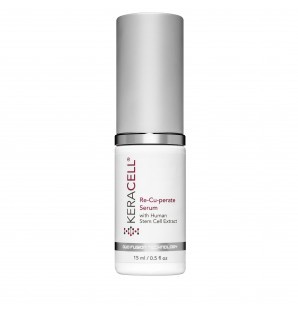
Re-Cu-Perate™ With MHCsc™ Technology
Highlights
Key Ingredients
Other Ingredients
Skim through
| Ingredient name | what-it-does | irr., com. | ID-Rating |
|---|---|---|---|
| Human Stromal Cell Derived Conditioned Media | |||
| Water/Aqua | solvent | ||
| Hyaluronic Acid | skin-identical ingredient, moisturizer/humectant | goodie | |
| Methylglucoside Phosphate | cell-communicating ingredient | goodie | |
| Copper Lysinate/Prolinate | cell-communicating ingredient | goodie | |
| Phenoxyethanol | preservative | ||
| Ethylhexylglycerin | preservative |
Keracell Re-Cu-Perate™ With MHCsc™ TechnologyIngredients explained

Good old water, aka H2O. The most common skincare ingredient of all. You can usually find it right in the very first spot of the ingredient list, meaning it’s the biggest thing out of all the stuff that makes up the product.
It’s mainly a solvent for ingredients that do not like to dissolve in oils but rather in water.
Once inside the skin, it hydrates, but not from the outside - putting pure water on the skin (hello long baths!) is drying.
One more thing: the water used in cosmetics is purified and deionized (it means that almost all of the mineral ions inside it is removed). Like this, the products can stay more stable over time.
- It’s naturally in our skin and behaves there like a sponge
- It can bind up to 1000 times its own weight in water
- It is a big molecule from repeated subunits (polymer) so different molecular weight versions exist (unfortunately there is no way to determine MW from INCI list only)
- High-molecular-weight-HA (>500 kDa) is an excellent surface hydrator, skin protectant and can act as an osmotic pump helping water-soluble actives to penetrate deeper into the skin
- Low-molecular-weight-HA (< 500 kDa) can hydrate the skin somewhat deeper though it is still a big molecule and works mainly in the epidermis (outer layer of the skin)
- Low-molecular-weight-HA might also help the skin to repair itself by increasing its self-defense (~ 200kDa used in the study)
- Ultra-low-molecular-weight-HA (<50kDa) is a controversial ingredient and might work as a pro-inflammatory signal molecule
It's a pretty new anti-aging ingredient that is a "safe and pre-activated source of energy to feed aging skin cells".
It's part of an anti-aging complex trade named Neodermyl, where methylglucoside phosphate is combined with the essential amino acids proline, lysine and also copper. This complex is claimed to be able to increase the collagen I and III production of skin and even more surprisingly, also the elastin production. Both slow down with age and beeing able to boost the skin's own production of these super important proteins results in improved skin firmness and elasticity.
This is a very big deal, especially the elastin part, as there is not yet a clinically proven active ingredient that is able to boost the skin's own elastin production. There are also very few ones (think vitamin C, glycolic acid, and retinol) that are proven to boost collagen. The claims about Neodermyl are not yet confirmed in independent studies but the manufacturer did do some very convincing testing that showed a visible reduction of wrinkle depth and volume in just 15 days. If you are into anti-aging, this is a new active that might be worth a try.
An essential amino acid - mineral complex that is part of the pretty new anti-aging complex called Neodermyl. The manufacturer claims that the complex is able to boost skin's own collagen I and III as well as elastin production. Read more details at methylglucoside phosphate.
It’s pretty much the current IT-preservative. It’s safe and gentle, but even more importantly, it’s not a feared-by-everyone-mostly-without-scientific-reason paraben.
It’s not something new: it was introduced around 1950 and today it can be used up to 1% worldwide. It can be found in nature - in green tea - but the version used in cosmetics is synthetic.
Other than having a good safety profile and being quite gentle to the skin it has some other advantages too. It can be used in many types of formulations as it has great thermal stability (can be heated up to 85°C) and works on a wide range of pH levels (ph 3-10).
It’s often used together with ethylhexylglycerin as it nicely improves the preservative activity of phenoxyethanol.
If you have spotted ethylhexylglycerin on the ingredient list, most probably you will see there also the current IT-preservative, phenoxyethanol. They are good friends because ethylhexylglycerin can boost the effectiveness of phenoxyethanol (and other preservatives) and as an added bonus it feels nice on the skin too.
Also, it's an effective deodorant and a medium spreading emollient.
You may also want to take a look at...
| what‑it‑does | solvent |
| what‑it‑does | skin-identical ingredient | moisturizer/humectant |
| what‑it‑does | cell-communicating ingredient |
| what‑it‑does | cell-communicating ingredient |
| what‑it‑does | preservative |
| what‑it‑does | preservative |





